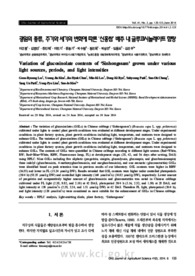

PARTNER
검증된 파트너 제휴사 자료
광원의 종류, 주기와 세기의 변화에 따른 ‘신홍쌈’ 배추 내 글루코시놀레이트 함량 (Variation of glucosinolate contents of ‘Sinhongssam’ grown under various light sources, periods, and light intensities)
9 페이지
최초등록일 2025.03.29
최종저작일
2014.06

-
미리보기
서지정보
· 발행기관 : 충남대학교 농업과학연구소
· 수록지 정보 : Korean Journal of Agricultural Science / 41권 / 2호 / 125 ~ 133페이지
· 저자명 : 이건령, 김영진, 천진혁, 이민기, 류동기, 박수형, 정선옥, 박상언, 임용표, 김선주
초록
The variation of glucosinolates (GSLs) in Chinese cabbage (‘Sinhongssam’) (Brassica rapa L. spp. pekinensis) cultivated under lights to control plant growth conditions was evaluated at different development stages. Under experimental conditions in plant factory system, plant growth conditions including light, temperature, and nutrients were designed to enhance GSLs. The variation of glucosinolates (GSLs) in Chinese cabbage (‘Sinhongssam’) (Brassica rapa L. spp. pekinensis) cultivated under lights to control plant growth conditions was evaluated at different development stages. Under experimental conditions in plant factory system, plant growth conditions including light, temperature, and nutrients were designed to enhance GSLs. The contents of GSLs were quantified in Chinese cabbage according to different light sources (Red+White, RW; Red+Blue+White, RBW, Fluorescence lamp, FL) at development stages (28, 42, and 56 days after sowing, DAS) using HPLC. Nine GSLs including five aliphatic (progoitrin, sinigrin, glucoalyssin, gluconapin, and glucobrassicanapin) three indolyl (glucobrassicin, 4-methoxyglucobrassicin, and neoglucobrassicin), and one aromatic (gluconasturtiin) GSLs were identified based on peak retention time in previous results of our laboratory. GSL contents were higher in RBW (36.55) and lower in FL (15.24 μmol/g DW). Results revealed that GSL contents were higher under controlled photoperiods (20/4 h) (58.35 μmol/g DW) and controlled light intensity (160 μmol/m2/s) (34.02 μmol/g DW), respectively. Lower amount of progoitrin and comparatively higher amount of glucobrassicin and gluconasturtiin was noted in Chinese cabbage cultivated under FL light (2.38, 9.82, and 2.10) at 42 DAS, photoperiod 20/4 h (3.16, 2.52, and 1.30) at 28 DAS, and light intensity at 130 μmol/m2/s (2.28, 2.24, and 1.51 μmol/g DW) at 42 DAS. Therefore FL light, photoperiod (20/4 h), and light intensity (130 μmol/m2/s) were considered as most suitable for the enhancement of GSLs in Chinese cabbage.영어초록
The variation of glucosinolates (GSLs) in Chinese cabbage (‘Sinhongssam’) (Brassica rapa L. spp. pekinensis) cultivated under lights to control plant growth conditions was evaluated at different development stages. Under experimental conditions in plant factory system, plant growth conditions including light, temperature, and nutrients were designed to enhance GSLs. The variation of glucosinolates (GSLs) in Chinese cabbage (‘Sinhongssam’) (Brassica rapa L. spp. pekinensis) cultivated under lights to control plant growth conditions was evaluated at different development stages. Under experimental conditions in plant factory system, plant growth conditions including light, temperature, and nutrients were designed to enhance GSLs. The contents of GSLs were quantified in Chinese cabbage according to different light sources (Red+White, RW; Red+Blue+White, RBW, Fluorescence lamp, FL) at development stages (28, 42, and 56 days after sowing, DAS) using HPLC. Nine GSLs including five aliphatic (progoitrin, sinigrin, glucoalyssin, gluconapin, and glucobrassicanapin) three indolyl (glucobrassicin, 4-methoxyglucobrassicin, and neoglucobrassicin), and one aromatic (gluconasturtiin) GSLs were identified based on peak retention time in previous results of our laboratory. GSL contents were higher in RBW (36.55) and lower in FL (15.24 μmol/g DW). Results revealed that GSL contents were higher under controlled photoperiods (20/4 h) (58.35 μmol/g DW) and controlled light intensity (160 μmol/m2/s) (34.02 μmol/g DW), respectively. Lower amount of progoitrin and comparatively higher amount of glucobrassicin and gluconasturtiin was noted in Chinese cabbage cultivated under FL light (2.38, 9.82, and 2.10) at 42 DAS, photoperiod 20/4 h (3.16, 2.52, and 1.30) at 28 DAS, and light intensity at 130 μmol/m2/s (2.28, 2.24, and 1.51 μmol/g DW) at 42 DAS. Therefore FL light, photoperiod (20/4 h), and light intensity (130 μmol/m2/s) were considered as most suitable for the enhancement of GSLs in Chinese cabbage.참고자료
· 없음태그
-
자주묻는질문의 답변을 확인해 주세요

꼭 알아주세요
-
자료의 정보 및 내용의 진실성에 대하여 해피캠퍼스는 보증하지 않으며, 해당 정보 및 게시물 저작권과 기타 법적 책임은 자료 등록자에게 있습니다.
자료 및 게시물 내용의 불법적 이용, 무단 전재∙배포는 금지되어 있습니다.
저작권침해, 명예훼손 등 분쟁 요소 발견 시 고객센터의 저작권침해 신고센터를 이용해 주시기 바랍니다. -
해피캠퍼스는 구매자와 판매자 모두가 만족하는 서비스가 되도록 노력하고 있으며, 아래의 4가지 자료환불 조건을 꼭 확인해주시기 바랍니다.
파일오류 중복자료 저작권 없음 설명과 실제 내용 불일치 파일의 다운로드가 제대로 되지 않거나 파일형식에 맞는 프로그램으로 정상 작동하지 않는 경우 다른 자료와 70% 이상 내용이 일치하는 경우 (중복임을 확인할 수 있는 근거 필요함) 인터넷의 다른 사이트, 연구기관, 학교, 서적 등의 자료를 도용한 경우 자료의 설명과 실제 자료의 내용이 일치하지 않는 경우
“Korean Journal of Agricultural Science”의 다른 논문도 확인해 보세요!
-
지방산 종류에 따른 Diacylglycerol의 효소적 개질 연구 7 페이지
Diacylglycerol-oil (DAG oil) and four kinds of fatty acids〔C16:0, C18:0, perillar oil-hydrolyzate(C18:3, 59.7%) and docosahexaenoic acid(DHA, C22:6, 63.7%)〕 were enzymatically esterified with 1:0.5, 1.. -
추풍령의 일사량과 대기투과율의 특성 분석 7 페이지
The surface solar radiation is an important indicators for climate and agricultural research over the Earth system. For the climate and agricultural research, long-term meteorological data and accurat.. -
무지개 당근의 carotenoid와 당 함량 분석 6 페이지
Coloring agents in food materials plays important roles in the development of attractive products as well as in the functionality of food such as antioxidant or vitamin supplementation. Carrot has bee.. -
한국 논에서 제초제 저항성잡초의 발생 현황, 메카니즘 및 방제 15 페이지
Sulfonylurea (SU)-resistant weeds of eight annual weeds, Monochoria vaginalis, Scirpus juncoides and Cyperus difformis, etc., and four perennial weeds, Scirpus planiculmis, Sagittaria pigmaea, Eleocha..
문서 초안을 생성해주는 EasyAI
